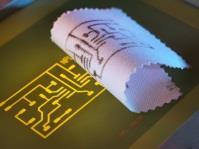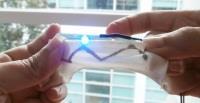Printing circuits directly onto fibres could open more reliable ways to provide real time healthcare in everyday lives. Electronics integrated into clothing could open up new opportunities for the NHS and patients, writes Kathryn Wills

Keeping track of patients’ vital signs in and out of the hospital can be hugely beneficial to healthcare professionals.
Devices from watches to sports sensors are offering promise for remote healthcare, but as yet haven’t been able to reliably capture and communicate the really valuable information.
But progress is coming in this area from research into integrating electronics directly into the fabric of clothing.
The potential for wearable sensors
Sensors placed on the right part of the body can provide detailed, real time information.
Patients can be continuously monitored away from the hospital. If there is a warning sign – high blood pressure, swelling, and so on – medical professionals can be alerted.
‘Pharma companies could use the data to better understand how their drugs perform outside the lab’
The data collected can also reveal insights into the effectiveness of treatments. This can be used to develop personalised recovery plans – even adapting during the process – without the need for check-ups.
Pharma companies could use the data to better understand how their drugs perform outside the lab.
This could revolutionise remote healthcare, allowing more patients to live normal lives, reducing hospital admin and freeing up beds.
Making sensors work for healthcare
Simple sensors are already widely used for healthcare, but we are yet to see sensors that can pick out minor physiological fluctuations, whilst integrating unnoticed into everyday living.
Mats on beds can detect bedsores, and fall sensors have long been available.
‘The drivers of wearables in healthcare are accuracy and reliability’
Clip-on sensors have been used in sport, but they must be visibly attached, so are unsuitable for monitoring conditions patients may not want to draw attention to.
So the drivers of wearables in healthcare are accuracy and reliability, as well as needing to discreetly integrate into daily routines.
This is why smart fabrics are so exciting; they can provide additional functionality to clothing that would be worn anyway.
Working electronics into clothing
So far, smart fabric techniques have looked at weaving conductive wires into clothing to create circuits. There are limits to this, given these wires must be integrated into design from the start, they offer limited flexibility.

A solution, being researched between the National Physical Laboratory and Coventry University, lies in printing conductive circuits directly onto fibres of complete garments. This means they become part of the clothing, and allow fabrics to stretch and wash.
To do this, silver nanoparticles are first chemically bound onto individual fibres. Copper does not bind to fibres, but it does bind to the nanoparticles, so this allows the creation of conductive copper layer which encapsulates fibres. This creates a good adhesion even when fibres are flexed and stretched.
The process can print complex circuits onto existing clothing, with inkjet printing possible for the first step.
Real time monitoring anywhere
Circuit printing opens up the possibility for clothing to become reliable circuits. It will allow networks of sensors to be precisely positioned across the area to be monitored and won’t be affected as clothes move on the body.
‘When fabric stretches there’s a change in electrical resistance, which can be accurately measured’
Smart textiles are already beginning to appear. A company called Footfalls & Heartbeats has developed smart compression bandages for venous ulcers. When the fabric stretches there is a change in electrical resistance, which can be accurately measured. So bandages can indicate if they are too tight or too loose, and also detect swelling.
It currently knits in conductive yarns, which act as the connecting wires, but the company is looking into printing circuits to make the product more robust.
What next?
Textile circuit printing has been successfully demonstrated on a variety of materials including cotton, polyester and linen. Cotton has proven especially successful, and shown little deterioration in 100 washes.
The next steps are further developing the chemical deposition process on materials other than cotton. Then we need to scale up the process, which is likely to be via a commercial partnership.

With the right interest, this technology could be employed in the healthcare profession within 3-5 years.
Wearables are not at the stage yet where they can be relied on for remote healthcare. But that is changing.
Printing circuits directly onto fibres could open more reliable ways to provide real time healthcare in everyday lives. It is not the only method of doing so, but it is the most robust we are aware of.
Electronics integrated into clothing could open up many new opportunities – bringing huge benefits to healthcare professionals and patients.
Dr Kathryn Wills is KTP associate – smart textiles at National Physical Laboratory and Coventry University



























No comments yet